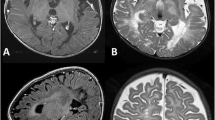Summary
The CT and MRI appearances of 5 patients with Cockayne's syndrome, 5 with ataxia telangiectasia and 1 with Fanconi's anaemia are reported. These conditions, together with Bloom's syndrome and xeroderma pigmentosum are regarded as disorders of DNA repair. Characteristic CT and MRI features of Cockayne's syndrome include generalised atrophy, calcification in basal ganglia and dentate nuclei and white matter low density. Neuroradiological findings in the other DNA repair disorders are nonspecific.
Similar content being viewed by others
References
Cockayne EA (1936) Dwarfism with retinal atrophy and deafness. Arch Dis Child 11: 1–8
Venema J, Mullenders LH, Natarajan AT, van Zeeland AA, Mayne CV (1990) The genetic defect in Cockayne syndrome is associated with a defect in repair of UV induced DNA damage in transcriptionally active DNA. Proc Natl Acad Sci USA 87: 4707–4711
Timme TL, Moses RE (1988) Diseases with DNA damage processing defects. Am J Med Sci 295: 40–48
Patton MA, Giannelli F, Francis AJ, Baraitser M, Harding B, Williams AJ (1989) Early onset Cockayne syndrome: case reports with neuropathological and fibroblastic studies. J Med Genet 26: 154–159
Talwar D, Smith SA (1989) CAMFAK syndrome. Am J Med Genet 34: 194–198
Levinson P, Zimmerman W, Grammet L, Lewis A, Spackman J (1982) Cockayne syndrome. JCAT 6: 1172–1174
Dabbagh O, Swaiman KF (1988) Cockayne syndrome: MRI correlation of hypomyelination. Ped Neurol 4: 113–116
Nishio H, Kodama S, Matsuo T, Ichihashi M, Ito H, Fujiwara Y (1988) Cockayne syndrome: MRI of the brain in a severe form with early onset. J Inherit Metab Dis 11: 88–102
Boltshauser E, Yalcinkaya C, Wichmann W, Reuter F, Prader A, Valavanis A (1989) MRI in Cockayne syndrome type I. Neuroradiology 31: 276–277
Demaerel P, Wilms G, Verdru P, Carton H, Baert AL (1990) MRI in the diagnosis of Cockayne syndrome. J Neuroradiology 17: 157–160
Sieg KG, Gaffney GR, McMillan JH (1990) MRI of brain abnormalities in Cockayne syndrome. Kans Med 91: 293–294
Valk J, van der Knaap MS (1989) MRI in myelin, myelination and myelin disorders. Springer-Verlag pp 149–154
Tomimoto H, Hirose S, Akiguchi I, Nishigoori C, Kamemaya M (1989) Xeroderma pigmentosum presenting clinical features of spinocerebellar degeneration. Rinsho Shinkeigaku 29: 172–176
Mimaki T, Tagawa T, Tanaka J, Sato K, Yabuuchi H (1989) EEG and CT abnormalities in xeroderma pigmentosum. Acta Neurol Scand 80: 136–141
Bloom D (1954) Congenital telangiectatic erythema resembling lupus erythematosus in dwarfs. Am J Dis Child 88: 754–758
Soffer D, Grotsky HW, Rapin I, Suzuki K (1979) Cockayne syndrome: unusual neuropathological findings and review of the literature. Ann Neurol 6: 340–348
Araki Y, Furukawa T, Tsuda K, Yamamoto T, Tsukaguchi I (1990) High field MRI of the brain in pseudohypoparathyroidism. Neuroradiology 32: 325–327
Author information
Authors and Affiliations
Rights and permissions
About this article
Cite this article
Demaerel, P., Kendall, B.E. & Kingsley, D. Cranial CT and MRI in diseases with DNA repair defects. Neuroradiology 34, 117–121 (1992). https://doi.org/10.1007/BF00588156
Received:
Issue Date:
DOI: https://doi.org/10.1007/BF00588156




